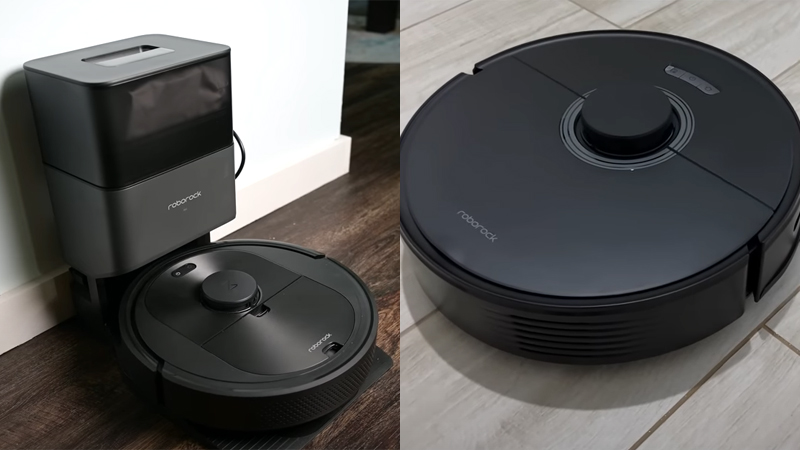In this article, I’ll be putting two top-level Roborock robot vacuums head-to-head: Roborock Q5+ vs Q7 Max. The Roborock Q5+ can only vacuum and has a self-cleaning base, while the Roborock Q7 Max can vacuum and mop at once. My personal preference leans towards the latter, but just keep reading to the end so you can decide which one best suits your living space and daily cleaning needs.
Roborock Q5+ Vs Q7 Max: Comparison Chart




Roborock Q5+ Vs Q7 Max: Differences
The Q7 Max wins 4-1 against the Q5+. Let’s keep reading to take a closer look at the key distinctions that set these two contenders apart.
Cleaning Performance
Winner: Roborock Q7 Max
Suction Power
| Roborock Q5+ | Roborock Q7 Max | |
|---|---|---|
| Max Suction (Pa) | 2700 | 4200 |
| Max Airflow (CFM) | ≈ 16.9 | ≈ 15.8 |
Regarding quoted suction power, the Q7 Max has the upper hand with a 4200 Pa stronger suction, whereas the Q5+ maxes out at 2700 Pa. However, my airflow experiments reveal that the latter has a lower maximum airflow. Through numerous trials with robot vacuums, I’ve discerned a link between high airflow and debris pick-up on hard floors, and yes, the Q5+ did a better job on my hardwood floor.
Hard Floor
| Roborock Q5+ | Roborock Q7 Max |
|---|---|
| ≈ 98% | ≈ 97% |
While the suction power varied, the difference in performance between these two Roborocks was minimal during the hardwood floor test. Both did well, with the Q5+ having a slight edge due to its superior airflow.
Carpet
| Roborock Q5+ | Roborock Q7 Max | |
|---|---|---|
| Low-pile Carpet | ≈ 97% | ≈ 94% |
| High-pile Carpet | ≈ 94% | ≈ 95% |
Despite the higher airflow, the Q5+ didn’t do as well as the Q7 Max on both carpets. My theory was that the Q7 Max’s bristle-free brush roller is superior to the combo brush on the Q5+ when it comes to agitating and lifting dirt from carpets.
Hair
| Roborock Q5+ | Roborock Q7 Max | |
|---|---|---|
| 5-inch Strands | ≈ 78% | ≈ 87% |
| 10-inch Strands | ≈ 51% | ≈ 61% |
The Q7 Max, with the newer bristle-less brush, performed better with five and ten-inch strands. Its brush wasn’t entirely resistant to hair tangles, but at least untangling it was much easier compared to the Q5+.
Design & Usability
Winner: Roborock Q7 Max
First Look & Dimensions
| Roborock Q5+ | Roborock Q7 Max | |
|---|---|---|
| Dimensions (W x H) | 13.8 x 4.17 inches | 13.78 x 3.78 inches |
| Weight | 9.59 lbs | 7.05 lbs |
In terms of design and dimensions, these robotic cleaners are very similar. The Q5+ is a bit taller, but that doesn’t prevent it from getting under the majority of low-clearance furniture pieces, such as sofas and coffee tables. The Q5+ ships with a big home base, which takes up a lot of space compared to the compact charging dock of the Q7 Max. However, the Q5+’s larger home base negates the need for manual dust bin emptying, while you’ll have to empty the Q7 Max’s bin yourself when it gets full.
Extractor & Side Brush
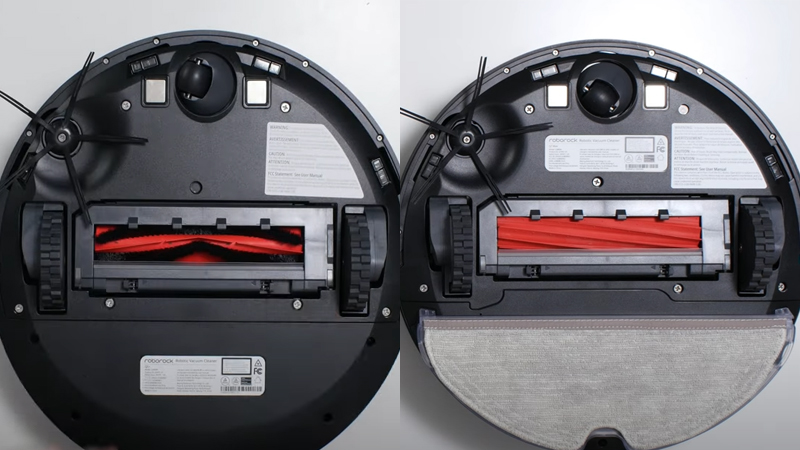
These Roborocks share an all-rubber side brush that comes with better durability than the bristled one found in older models. It doesn’t spin too fast, preventing debris scatter and thus enhancing cleaning efficiency. Their main rollers are different: the Q7 Max utilizes an all-rubber roller, which not only provides superior agitation but also makes it easier to clean and dry than the combo roller on the Q5+.
MAPPING & NAVIGATION
Both the Q5+ and Q7 Max boast a LiDAR module, generally found in aero-technology, that uses lasers to draw a highly precise map of your home in both 2D and 3D forms and you can access them from the Roborock Home App. Not only that, but LiDAR tech allows these bots to function properly both day and night.
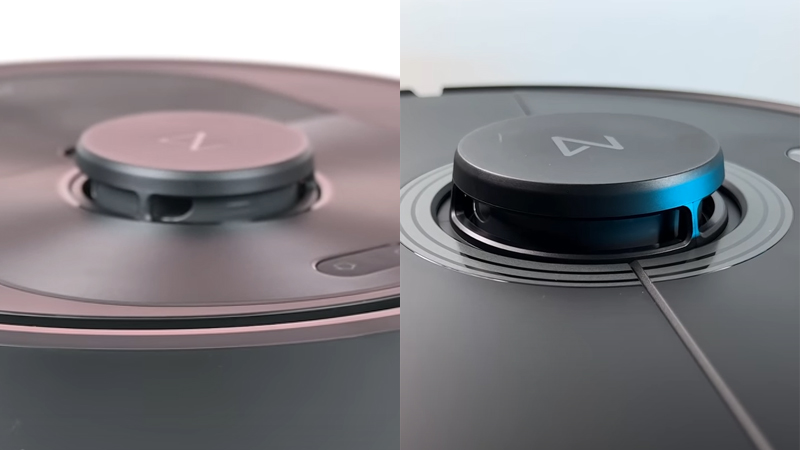
Speaking of map saving, both can save up to four areas or floors of your home and you can customize each level, such as dividing rooms, adding no-go zones, etc. Having a robot vacuum repeatedly draw and redraw as it moves from floor to floor is annoying. Thankfully, that is not the case with these robots.
They have no obstacle avoidance algorithm, so they will bump here and there a few times while doing the job. This can be a big problem if your floors are regularly littered with pet feces, electrical wires, or any other small objects that their laser-based navigation towers can’t detect. For these cases, consider a robovac with a front-facing camera like the Roborock S7 MaxV or Roomba J7 Plus, for example.
Battery Life
| Roborock Q5+ | Roborock Q7 Max | |
|---|---|---|
| Battery Life | ≈ 98–164 mins | ≈ 91-183 mins |
| Charging Time | ≈ 172 mins | ≈ 231 mins |
Both operate on a 5200 mAh lithium-ion battery, which is advertised to provide up to 3 hours of operation on a full charge. In my real-world tests, the Q5+ had a slightly shorter maximum battery life, but I thought it would be enough to vacuum the entire home in most cases, and, of course, so did the Q7 Max.
But what happens if not? I mean, what happens when their batteries reach down while they are in the middle of a cleaning cycle? Just don’t worry! If their battery becomes low midway through cleaning, they will return to their base stations and perform top-up charging before heading back to the exact location they left off. That way, every inch of your floor gets the attention it deserves.
Control
Winner: Roborock Q7 Max
Manual Control
There are a few buttons on top of these bots for physical controls. Both have one power button and one home button. Unique to the Q7 Max is another button for spot cleaning. I understand if you use your phone to remotely control your robot most of the time, but these physical buttons are your lifesaver when your phone is out of reach or there is something wrong with your WiFi.
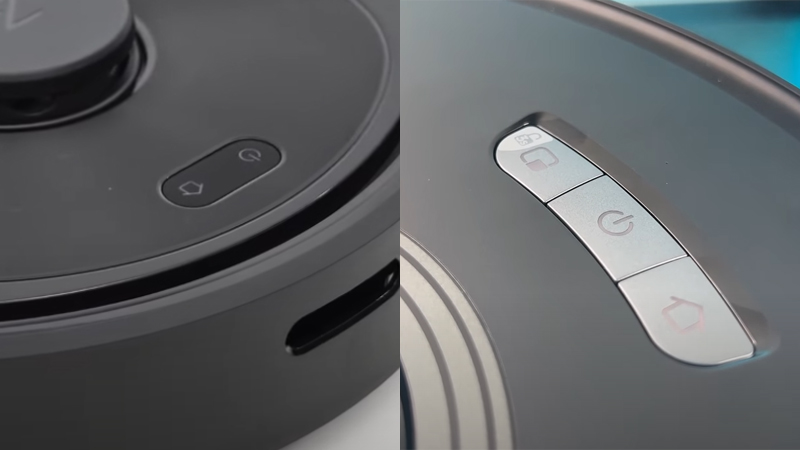
App Connectivity
Each of these robots can be paired with the Roborock Home app, offering all the tools you need to remotely control or manage your bot. You can choose among up to four maps, show it in 2D or 3D form, and see the robot’s location as well as its vacuuming routes in real time.
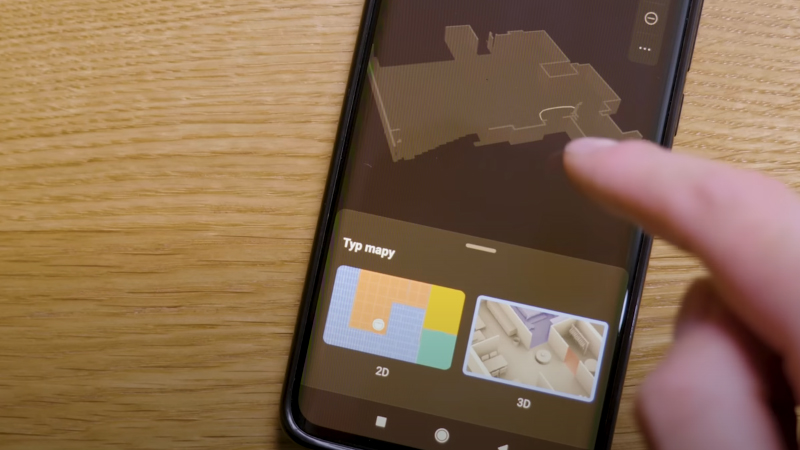
You can also use virtual boundaries to divide rooms, name them, and program the Q5+/Q7 Max to pinpoint a specific room to clean – there are two options to do that. You can simply tap on the room of your choice on the map or use a voice-activated device such as Alexa or Google Assistant to instruct your robot accordingly. What’s more, you also have the option to schedule cleaning that suits your needs.
To block some areas inside your house, you have the option to set no-go zones and invisible walls (and no-mop zones if you choose the Q7 Max). Conversely, you can set clean zones to spot-clean rectangular or square zones, but they aren’t savable for future use, unlike in the iRobot app.
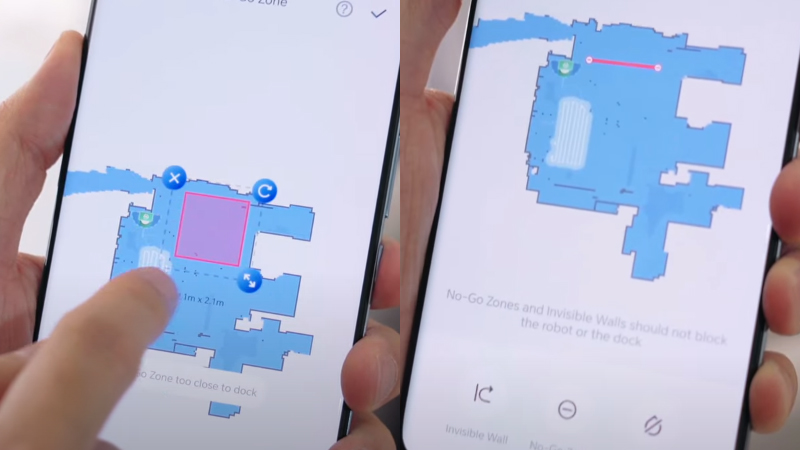
There is also a cleaning history that shows a log of the previous cleaning cycles, including the cleaned area, total time used, cycles, etc. Meanwhile, the maintenance tab shows the health of components like the main brush, side brush, filter, etc, and alerts you when it’s time for them to be cleaned or replaced.
Cleaning & Maintenance
Winner: Roborock Q5+
Of course, you need to treat your robot vacuum well if you want it to treat you well in the long run. The maintenance checklist should include untangling the roller, cleaning the side brush, washing the E11 filters, replacing consumables when the app tells you to, washing the mopping plate (on the Q7 Max), and emptying the dustbin. While the Q7 Max requires a hands-on approach to emptying the bin, the Q5+ comes with a nifty self-emptying base that does the dirty job for you. Still, the Q5+’s base has one major shortcoming.
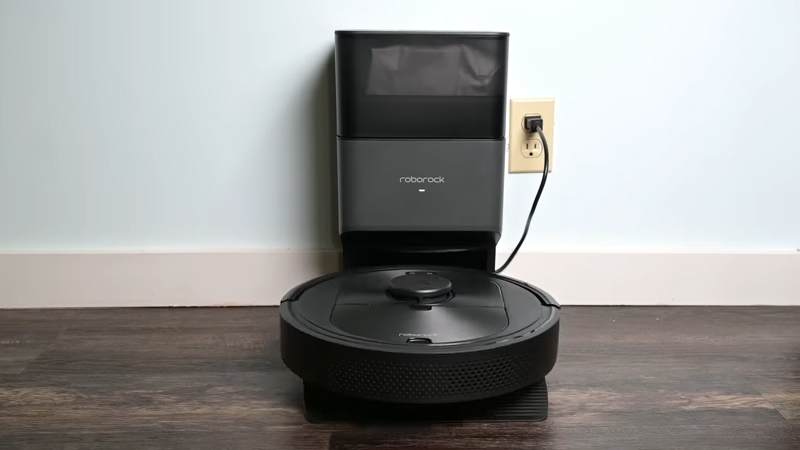
Most other self-emptying robots out there have auto-empty sensors that recognize when their dust boxes are full and automatically send them back to their base for a quick emptying cycle, but the Q5+ is an exception. Its dustbin is still auto-emptied whenever it re-docks after a cleaning process, but if its dustbin fills before it is done cleaning, you must physically press its home button to send it back to the dock for emptying. So, after all, the Q5+ still demands your attention during its cleaning operations, even if it has a self-cleaning base.
As for the Q7 Max, it comes with a simple and compact charging dock, and you will need to use your hands to empty its dust bin, refill its water tank, and wash its mopping pad. By the way, the Q7 Max “Plus” also comes with a self-cleaning base, but it solely takes care of emptying the dustbin.
Other Features
Winner: Roborock Q7 Max
Noise
| Roborock Q5+ | Roborock Q7 Max | |
|---|---|---|
| Working | ≈ 59-64 dB | ≈ 49-62 dB |
| Self-Emptying | ≈ 74 dB | None |
The Q5+ is a bit noisier when operating, no matter what mode it is in, despite its lower suction power. What’s more, it’s especially noisy during the bin-emptying process. Just remember this if your household includes toddlers, pets, or anyone with a sensitivity to sudden loud noises.
Mopping Ability
The mopping function is equipped in the Q7 Max, not in the Q5+. Still, I didn’t really consider it a revolutionary addition since it has no agitation or vibrating element. It doesn’t boast any agitation or vibrating mechanisms – it opts to simply drag a damp microfiber mop pad across your floors instead. This method is less effective when it comes to tackling stubborn stains. To compare, the S7 MaxV features a vibrating pad and could handle dust and stains well in my tests.
Quick Rundown Of Roborock Q7 Max
- Deeper Cleaning with Powerful 4,200 Pa Suction: With 4,200 Pa maximum suction, the Q7 Max effortlessly lifts debris and pet hair from floors, drags dirt from cracks, and deep-cleans carpets; it automatically boosts suction when carpets are detected, ensuring thorough cleaning
- Vacuum and Mop Simultaneously: To eliminate fine dust that vacuuming alone might miss, this robot vacuum can vacuum and mop in one go; its electronic pump offers 30 adjustable water flow levels, allowing you to customize cleaning based on floor type and preference
- Clean Smarter with PreciSense LiDAR Navigation: Highly accurate LiDAR technology builds precise 3D maps of your home and identifies the most efficient cleaning routes; virtually recreate your space by adding furnishings and flooring materials for a more tailored cleaning experience
- Combined Dustbin & Water Tank: The 470 ml dustbin and 350 ml water tank combination supports longer cleaning sessions without the need for frequent emptying or refilling
- Effortless Cleaning with All-Rubber Brush: The all-rubber brush is specifically designed to resist tangles from long hair and pet hair; its multi-directional floating design maintains close contact with the floor, ensuring deeper and more efficient cleaning
Quick Rundown Of Roborock Q5+
- 7-Weeks of Hands-Free Cleaning: The Self-Empty Dock automatically empties the Q5’s dustbin after each cleanup, so you don’t have to do it manually or frequently. Its 2.5L dust bag can hold up to 7 weeks of dirt.
- Clean Smarter with PreciSense LiDAR Navigation: Extremely accurate LiDAR navigation creates precise maps that can even be viewed in 3D. You can also add furniture and floor materials to recreate your home virtually.
- Clean Harder with Powerful 2700 Pa Suction: With an incredible maximum suction power of 2700 Pa, the Q5 easily lifts debris and pet hair from floors and drags it out from deep inside carpets.
- Clean Better with the Multi-Plane Floating Main Brush: A multi-plane floating brush keeps the brush closer to the ground for deeper cleaning, even on uneven surfaces. It is strongly resistant to hair tangles and perfect for homes with pets.
- Keeps Going for Longer: Powered by high-capacity battery and a 470 ml dustbin, you get long lasting cleaning that can easily tackle most homes in one clean.
Product Videos
Related Articles to Roborock Q7 Max
- An In-Depth Review Of The Roborock Q7 Max Vs Dreame L10 Pro: Which is Better?
- Roborock Q7 Max Vs S7: What Are the Differences Between Them?
- Roborock Q5 Vs Q7 Max: An In-Depth Analysis
- Roborock Q7 Max Vs Xiaomi S10T: A Detailed Comparison
- Roborock Q7 Max Vs Eufy X8: What Is The Best Option For Your Home?
- Viomi S9 Vs Roborock Q7 Max: Battle of the Feature-Rich Bots
- Viomi V5 Pro Vs Roborock Q7 Max: Which One Gets My Winning Ticket?
- Roborock Q7 Max Vs Dreame Z10 Pro: A Detailed Face-Off Comparison
- Roborock Q Revo Vs Q7 Max: Duel of the Roborock Dust-Suckers
- Dreame D10 Plus Vs Roborock Q7 Max: An In-Depth Comparison And Review
- Roborock Q7 Max Vs Q7: What Does The “Max” Label Refer To?
- Dreame D9 Max Vs Roborock Q7 Max: Which Chinese Brand Does the Job Better?
- Roborock Q7 Max Vs Q7 Max Plus: Is the Self-Cleaning Base A Game Changer?
- Roborock Q7 Max Vs S7 MaxV: Which Roborock Is Better?
- Roborock Q7 Max Vs iRobot J7: A Head-To-Head Comparison
Related Articles to Roborock Q5 Plus
- Roborock Q5+ Vs Roomba J6+: Which Self-Cleaning Robot Is Better?
- Roborock Q5+ Vs Roomba I7+: Which One is Better?
- What Is The Difference Between The Roborock Q5 Vs Q5+?
- Roborock Q5+ Vs Roomba S9+: Which is the Best Bang for the Buck?
- Roborock Q5+ Vs Roomba J7+: A Head-To-Head Comparison
References:
- Roborock Q7 Max: https://us.roborock.com/products/roborock-q7-max
- Roborock Q5+: https://us.roborock.com/products/roborock-q5-plus

Richard B. Schmidt is a prominent figure in the vacuum cleaner industry, boasting over 15 years of expertise. Armed with a Robotics Engineering degree from Northeastern University and a Master’s in Consumer Science from Harvard, his unique blend of technical knowledge and consumer insights positions him as a sought-after authority in vacuum cleaner evaluation. Richard’s career began at Dyson, where he contributed to the development of innovative vacuum models. Transitioning to advocacy and reviews, he co-founded the first Vacuum-focused blog in 2008, offering comprehensive analysis and user guides for various vacuum cleaners. In 2020, he founded RoboMop.net, providing ongoing insights through columns and buyer’s guides.
